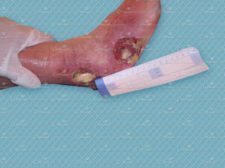Vascular Evaluation – Arterial Insufficiency
Many wounds seen by wound care specialists can be ascribed a vascular etiology, including arterial, venous, and diabetic wounds. In order to successfully manage wounds of this type, the underlying vascular dysfunction must first be addressed.
A number of tests and measures are available for detecting arterial insufficiency, the simplest of which is an assessment of the peripheral pulses in both extremities. The absence of a palpable pulse should be followed-up with more sensitive testing, including the use of Doppler ultrasound. This involves a handheld probe that produces an audible signal over moving fluid and gives a subjective test of arterial insufficiency.
The most popular method for the testing of arterial dysfunction is the ankle-brachial index (ABI), which provides a ratio of the systolic BP of the lower extremities to that of the upper extremities. The ABI is a reliable, noninvasive method for measuring peripheral tissue perfusion and presence of peripheral arterial disease and a good indicator of healing potential.
As an extension of the standard ABI, segmental pressure measurements help localize areas of decreased arterial blood flow and are suitable for identifying distal arterial occlusions or stenosis. Furthermore, plethysmography measures volume changes via cuff to assess regional blood flow while duplex scanning combines a Doppler probe with a scanner to offer data relating to blood flow, velocity, and turbulence.
Another method of assessing arterial sufficiency is capillary refill, a reliable indicator of surface arterial blood flow, in which patients exhibiting arterial insufficiency show delayed capillary refill. Venous filling time is also a good predictor for arterial insufficiency
Transcutaneous oxygen monitoring TcOM or TcPO2 uses series of electrodes adjacent to wound to assess the severity of peripheral vascular disease to assess levels of hypoxia. Wounds with periwound tissue oxygen tension levels <30 mmHg are unlikely to heal without surgical intervention.
If surgical revascularization is being considered, arteriography is often performed in which a radiopaque dye is injected into an artery to visualize blood flow. However, this technique does not form part of a standard wound assessment.
Learn More With Our Wound Care Education Options
Interested in learning more about wound care and certification? Browse through our wound care certification courses for information on our comprehensive range of education options to suit healthcare professionals across the full spectrum of qualifications and experience.
References
- Sussman C and Bates-Jensen B. Wound Care. A collaborative practice manual for health professionals. 3rd Ed. Wolters Kluwer/Lippincott Williams & Wilkins, Philidelphia, US. 2007.
- Myers BA. The Wound Care Practitioner. Taken from Wound Management: Principles and Practice 3rd ed. Upper Saddle River, NJ: Pearson; 2012.


Hi Laurie,
Can we do this as distance learner, or need to be there,
Please lett me know.
Thanks and best regards.
Gulnaz Tari
One of the best features of the WoundEducators.com wound certification course is that you proceed at your own pace from any location with Internet capability. No need for travel or time off from work. You’ll complete the course according to your schedule!
I like that you talked about the ankle-brachial index. My wife has been worried about having a vascular disease. I’ll have to ask her about getting an ABI check, just to be safe. Thanks for the information.
Best of luck with your wife Scott.
I want to know if I qualify to take the nurse practitioner wound care certification. I have had 7 years wound care experience as a nurse. I am an Adult-Gerontology Nurse practitioner, graduated 2017 and I am getting ready to start a wound care clinic in a cardiologist office will mostily see PAD and diabetic wounds. So my only experience with wounds have been as a nurse and not NP
Alice, you can certainly take our Nurse Practitioner course –
https://woundeducators.com/wound-care-certification-courses/nurse-practitioner-wound-care-certification-course/
You can also pursue the CWS certification or CWCN certification after completing our course. The course will provide all the wound care information needed to pass either exam.
Best of luck!
I am a cancer survivor post chemo and radiation. I read slower to comprehend better. I worry that I wont have enough time to finish the certification exam. Your thoughts?